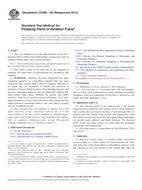Wir benötigen Ihre Einwilligung zur Verwendung der einzelnen Daten, damit Sie unter anderem Informationen zu Ihren Interessen einsehen können. Klicken Sie auf "OK", um Ihre Zustimmung zu erteilen.
ASTM D2386-06(2012)
Standard Test Method for Freezing Point of Aviation Fuels
Automatische name übersetzung:
Standard Test Method for Gefrierpunkt von Flugbenzin
NORM herausgegeben am 15.4.2012
Informationen über die Norm:
Bezeichnung normen: ASTM D2386-06(2012)
Anmerkung: UNGÜLTIG
Ausgabedatum normen: 15.4.2012
SKU: NS-20214
Zahl der Seiten: 5
Gewicht ca.: 15 g (0.03 Pfund)
Land: Amerikanische technische Norm
Kategorie: Technische Normen ASTM
Die Annotation des Normtextes ASTM D2386-06(2012) :
Keywords:
aviation gasoline, aviation turbine fuels, crystallization point, determination, freezing point, low temperature tests, manual method, petroleum products, physical tests, Freezing point--petroleum products/applications, Low-temperature testing--petroleum products/applications, Aviation turbine fuels, Crystallization, Manual method, Petroleum products, ICS Number Code 75.160.20 (Liquid fuels)
Ergänzende Informationen
| Significance and Use | ||||||||||||||||
|
The freezing point of an aviation fuel is the lowest temperature at which the fuel remains free of solid hydrocarbon crystals that can restrict the flow of fuel through filters if present in the fuel system of the aircraft. The temperature of the fuel in the aircraft tank normally falls during flight depending on aircraft speed, altitude, and flight duration. The freezing point of the fuel must always be lower than the minimum operational tank temperature. Freezing point is a requirement in Specifications D910 and D1655. |
||||||||||||||||
| 1. Scope | ||||||||||||||||
|
1.1 This test method covers the determination of the temperature below which solid hydrocarbon crystals may form in aviation turbine fuels and aviation gasoline. Note 1—The interlaboratory program that generated the precisions for this test method did not include aviation gasoline. 1.2 The values stated in SI units are to be regarded as standard. No other units of measurement are included in this standard. 1.3 WARNINGMercury has been designated by many regulatory agencies as a hazardous material that can cause central nervous system, kidney and liver damage. Mercury, or its vapor, may be hazardous to health and corrosive to materials. Caution should be taken when handling mercury and mercury containing products. See the applicable product Material Safety Data Sheet (MSDS) for details and EPA’s websitehttp://www.epa.gov/mercury/faq.htmfor additional information. Users should be aware that selling mercury and/or mercury containing products into your state or country may be prohibited by law. 1.4 This standard does not purport to address all of the safety concerns, if any, associated with its use. It is the responsibility of the user of this standard to establish appropriate safety and health practices and determine the applicability of regulatory limitations prior to use. For specific warning statements, see 5.4, Section 6, and 8.2. |
||||||||||||||||
| 2. Referenced Documents | ||||||||||||||||
|
Empfehlungen:
Aktualisierung der technischen Normen
Wollen Sie sich sicher sein, dass Sie nur die gültigen technischen Normen verwenden?
Wir bieten Ihnen eine Lösung, die Ihnen eine Monatsübersicht über die Aktualität der von Ihnen angewandten Normen sicher stellt.
Brauchen Sie mehr Informationen? Sehen Sie sich diese Seite an.




 Cookies
Cookies
